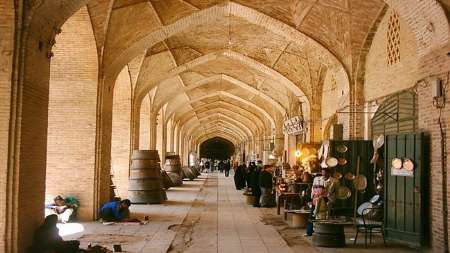
About 180 shops are placed on the right side of the bazaar. Several arches (taqnama) have been designed on the left side creating a beautiful view. Venders sell their goods under the arches, Tehran-based English newspaper, Iran Daily, reported.
There are 16 arches in the bazaar which are linked to the square. The bazaar itself, which stretches over an area of 534.5 sq.m., is 93 meters long and 5.75 meters wide.
Located 1,200 meters from Tohid Square, which is to the northeast to Shohada Square, Kerman’s grand bazaar is one of the oldest trading centers in Iran. The main bazaar has four smaller bazaars, and a further 20 or so branches off to the north and south. It is, however, easy enough to pass through the edifice.
Starting at Tohid Square, the first section is Ganjalikhan Bazaar, built in the 17th century CE for local governor Ganjalikhan.
It opened to Ganjalikhan Square. The courtyard is home to what was once Kerman’s most important public baths, Ganjalikhan Bathhouse which has been restored and converted into a museum. Wonderful frescoes adorn the walls while wax statues illustrate the workings of a traditional bathhouse.
The reception area was divided, so men involved in different trades could disrobe before entering the bath. On the eastern and western ends of the bathhouse, there are ‘time stones’, translucent, 10cm-thick alabaster doorways through which bathers could keep a rough track of the time by looking at the light outside.
On the north side of the courtyard is Bazaar-e Mesgari Shomali (Coppersmith’s Bazaar), and on the square’s northeastern end is Ganjalikhan Mosque — a lavishly decorated private mosque for Ganjalikhan.

Add new comment